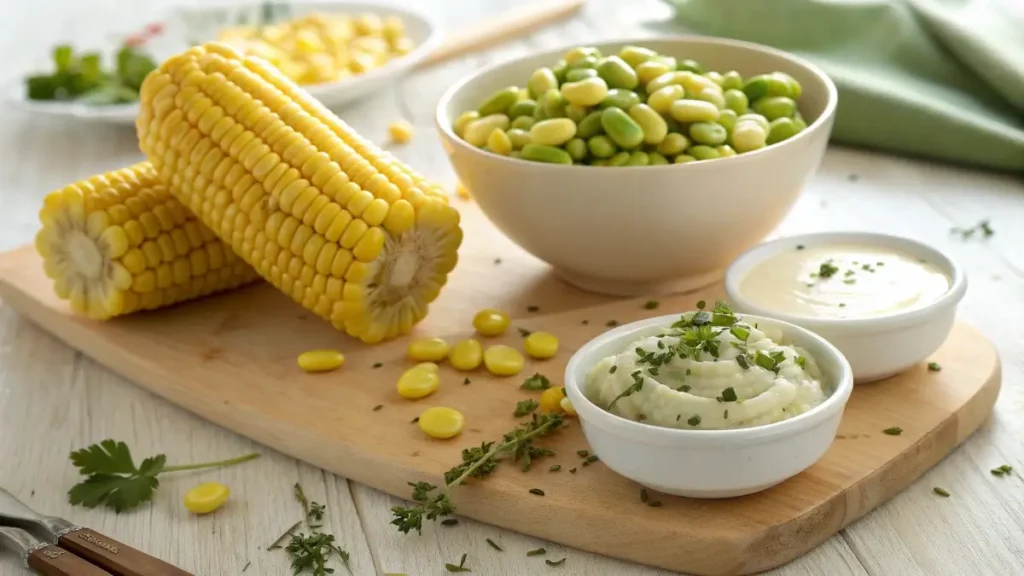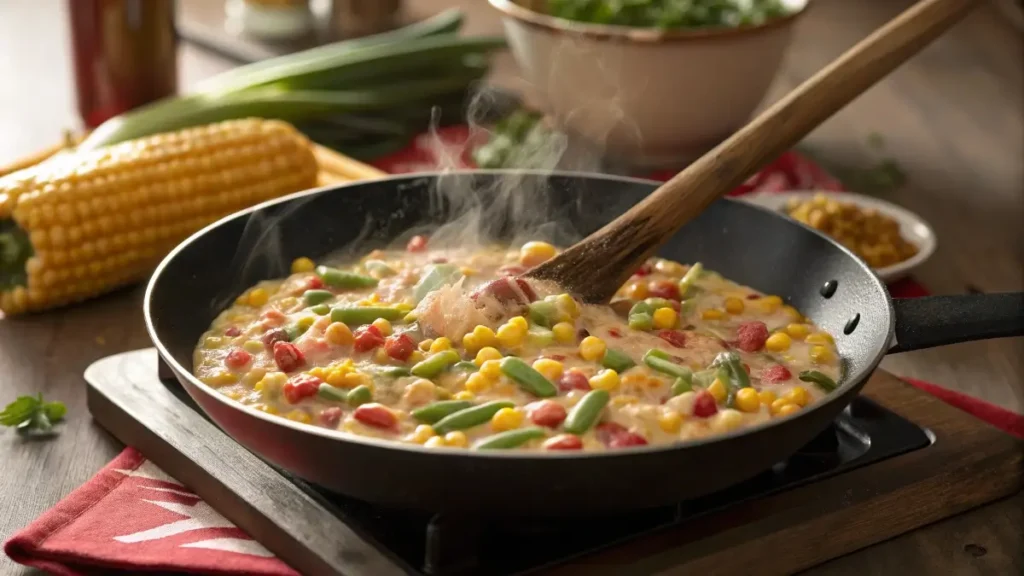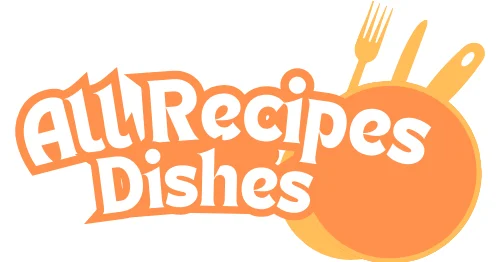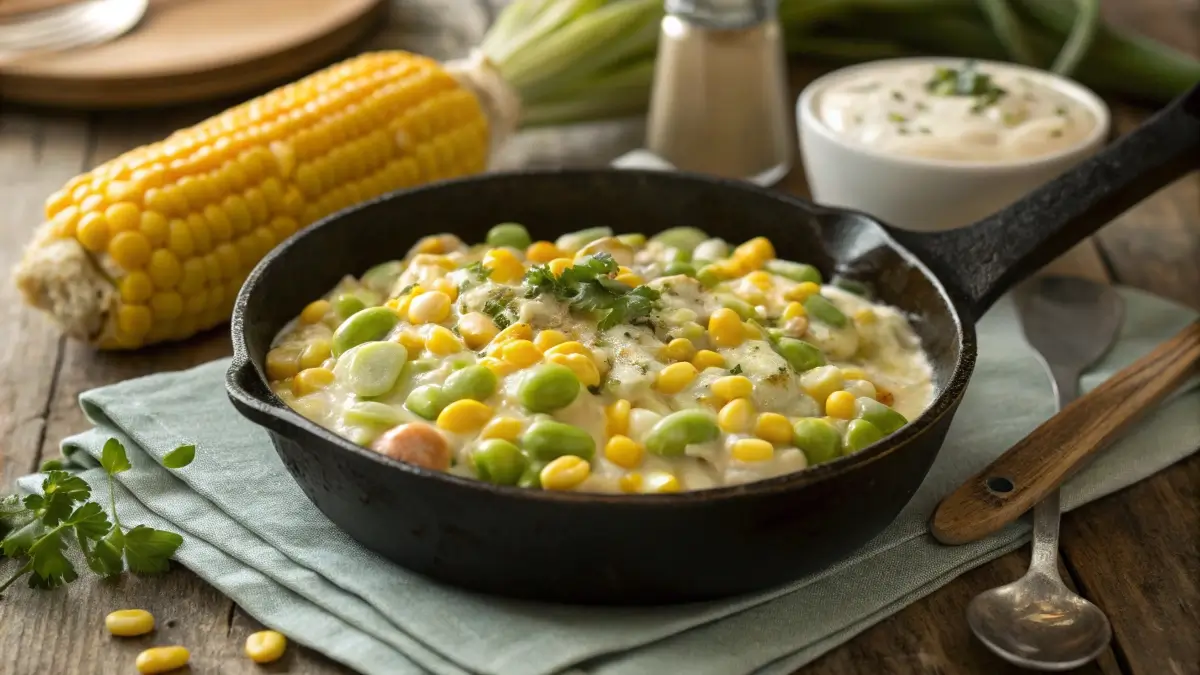Creamy Succotash Recipe: A Southern Classic with a Rich Twist
Creamy succotash recipe is more than just a side dish—it’s a slice of American food history served with rich, comforting flavors. From its Native American beginnings to its Southern kitchen fame, succotash has evolved into a dish that’s as versatile as it is delicious. In this article, we’ll explore the origins of succotash, the key ingredients that make it creamy and irresistible, substitutions for lima beans, and expert tips to perfect your recipe. We’ll also look at how Southern Living recommends preparing succotash, provide serving ideas, and answer common FAQs to help you master this Southern classic at home.
Looking for inspiration? Try our Southern comfort food recipes for more dishes that warm the table.
Table of Contents
History and Origins of Succotash
What was the original succotash?
The very first succotash wasn’t creamy at all—it was a simple but hearty combination of corn and beans made by Native American tribes in the Northeastern United States. Known as a “three sisters” dish, it often included corn, beans, and squash, three staple crops that worked together both nutritionally and agriculturally. This early succotash was a complete meal, providing protein, fiber, and essential vitamins in one humble bowl.
Native American roots and influence on Southern cuisine
Succotash spread beyond Native American communities when European settlers adopted the recipe. It quickly became a survival dish during lean seasons because of its easy-to-grow ingredients and high nutritional value. Over time, as the South embraced the dish, it was adapted with butter, cream, bacon, and fresh herbs, transforming it from a survival food into a comforting side served at Sunday dinners and holiday gatherings.
How succotash evolved into a comfort food staple
As Southern cooks personalized the recipe, creamy succotash gained its place alongside fried chicken, cornbread, and collard greens. Its versatility made it a favorite, whether served as a side dish or as a filling main course during tough times. Today, creamy succotash represents the fusion of Native American tradition and Southern ingenuity, showing how simple ingredients can become timeless comfort food.
Key Ingredients in a Creamy Succotash Recipe
What makes succotash?
At its heart, succotash is built on two essential ingredients—corn and beans. These form the foundation of every variation, whether traditional or creamy. Over the years, cooks have enriched the recipe with cream, butter, bacon, and fresh herbs, creating a dish that balances sweetness, savoriness, and smooth texture. The creamy succotash recipe stands out because it adds dairy richness that makes every spoonful comforting and indulgent.

Lima beans: the star of the dish
Lima beans, sometimes called butter beans in the South, are the classic bean used in succotash. Their mild, buttery flavor and soft texture perfectly complement the crunch of corn. Beyond taste, lima beans are loaded with protein, fiber, and nutrients like folate and magnesium. For many, succotash simply isn’t succotash without them.
Check out our guide on healthy bean recipes to explore more nutritious ways to enjoy legumes.
Corn and cream: balancing texture and flavor
Corn brings a natural sweetness and crisp bite that balances the creamy base of the recipe. Fresh summer corn is ideal, but frozen corn works just as well for convenience. The addition of heavy cream, milk, or even half-and-half is what gives the dish its signature creaminess. Some cooks also use cream cheese or sour cream to enhance richness while keeping the corn flavor front and center.
Fresh herbs and seasoning combinations
While the base is simple, seasoning makes creamy succotash shine. Salt, black pepper, paprika, and garlic are classic, while fresh herbs like parsley, thyme, and basil brighten the dish. Some Southern recipes call for a pinch of cayenne for a gentle kick. Herbs not only enhance flavor but also balance the heaviness of cream and butter. Don’t miss our Steak Seasoning Recipe to elevate simple side dishes like succotash.
Variations and Substitutions
What is a substitute for lima beans in succotash?
Not everyone loves lima beans, and sometimes they’re hard to find outside of the South. Luckily, there are plenty of substitutes that still capture the texture and flavor balance. Edamame, butter beans, navy beans, or cannellini beans are popular choices. Each of these provides creaminess without overpowering the corn. For a slightly nuttier flavor, edamame works beautifully in modern versions of creamy succotash.
What bean is closest to a lima bean?
The closest alternative to a lima bean is the butter bean, which is essentially just a mature lima bean with a larger size and creamier texture. In fact, in many Southern kitchens, lima beans and butter beans are used interchangeably. For recipes outside the South, white beans like great northern beans also mimic the texture and neutral flavor.
Dairy-free and vegan creamy succotash alternatives
Traditional creamy succotash recipes rely on heavy cream or milk, but you can easily make a vegan version. Swap out dairy cream for coconut milk, cashew cream, or oat cream to achieve the same velvety texture. Olive oil or vegan butter also makes the dish lighter while still keeping the Southern comfort appeal. Discover great ideas like vegan side dishes that turn classics into plant-based delights.
Southern vs. Northern versions of succotash
Regional differences play a big role in how succotash is prepared. In the South, it often includes cream, butter, bacon, or smoked ham for extra richness. By contrast, Northern versions tend to stick closer to Native American roots, highlighting corn, beans, and squash with fewer dairy-heavy additions. Both versions remain authentic to their region’s history, showing how succotash adapts to local traditions.
Step-by-Step Guide to Cooking Creamy Succotash
Choosing fresh vs. frozen ingredients
One of the best parts of a creamy succotash recipe is its flexibility. When corn is in season, fresh kernels sliced right off the cob bring unbeatable sweetness and crunch. But when time is tight or corn isn’t available, frozen corn works just as well without sacrificing flavor. The same goes for lima beans—frozen options are convenient and often just as nutritious as fresh. Using a mix of both fresh and frozen makes this dish achievable year-round.

Classic stovetop creamy succotash recipe
The stovetop method is the most traditional and straightforward way to prepare creamy succotash. Start by sautéing onions and garlic in butter until golden, then stir in lima beans and corn. Stir in cream, milk, or half-and-half and let the sauce simmer gently until it thickens. Finish with fresh herbs and seasonings, adjusting the flavor to taste. This method creates a rich, velvety texture without being overly heavy.
Check out our Slow Cooker Caprese Chicken for more quick family-friendly ideas.
One-pot creamy succotash method
For busy weeknights, a one-pot creamy succotash recipe is a lifesaver. All ingredients—onions, beans, corn, cream, and seasonings—are cooked together in a single skillet. This reduces cleanup and helps the flavors blend beautifully. A splash of vegetable or chicken broth can be added for depth, while a pinch of smoked paprika or cayenne gives it Southern flair.
Tips for thickening the cream base naturally
Nobody wants runny succotash. To achieve that perfect creamy consistency, here are a few natural tricks:
- Simmer slowly: Let the mixture reduce gently to thicken naturally.
- Use starchy beans: Butter beans or cannellini beans release starch that binds the sauce.
- Mash a few beans: Lightly crushing some beans into the cream makes the texture richer.
- Skip flour or cornstarch: These can make the dish gummy—natural reduction works best.
Don’t miss our expert cooking tips to elevate traditional Southern dishes like succotash.
Southern Living’s Take on Succotash
What does Southern Living suggest for your succotash?
When it comes to creamy succotash recipes, Southern Living often adds a signature Southern spin. They recommend incorporating bacon drippings as the cooking base to infuse the dish with smoky depth. Their take leans heavily on fresh summer vegetables, using sweet corn, cherry tomatoes, and lima beans to create a colorful, hearty side dish.
Southern Living’s cooking tips and techniques
Southern Living suggests sautéing vegetables in stages to maximize flavor. Onions and peppers are cooked until soft before adding beans and corn. Their creamy version calls for a splash of heavy cream but keeps it light enough to let the vegetables shine. They also advise garnishing with fresh basil or parsley to brighten the richness.
Unique ingredient additions from Southern Living
One of the standout ideas from Southern Living’s kitchen is the use of tomatoes or okra to add a Southern garden-fresh twist. These ingredients not only enhance flavor but also introduce more color and texture. A sprinkle of crispy bacon on top adds a finishing crunch that contrasts beautifully with the creaminess of the dish. Looking for inspiration? Try our Southern vegetable side dishes to bring regional authenticity to your table.
How their version differs from traditional recipes
While traditional succotash focuses mainly on lima beans and corn, Southern Living elevates it with seasonal produce, smoked meats, and fresh herbs. Their recipes tend to be more colorful, slightly lighter on cream, and layered with flavors that showcase Southern produce at its peak. This approach makes their creamy succotash not only delicious but also visually appealing for holidays, potlucks, and Sunday suppers.
Nutritional Value and Health Benefits
Calories and macronutrient breakdown
A standard serving of creamy succotash is both satisfying and nutrient-rich. On average, one cup contains around 200–250 calories, depending on how much cream or butter is used. The main macronutrients break down into:
- Carbohydrates from corn and beans, which provide energy.
- Protein from lima beans, giving the dish substance.
- Healthy fats from cream or butter, which contribute to the dish’s silky texture.
This creamy succotash is a hearty side dish that blends comfort with wholesome nutrition.
Fiber and plant-based protein benefits
Lima beans and corn both pack a good dose of dietary fiber, aiding digestion and promoting satiety. Fiber also helps regulate blood sugar levels, making succotash a surprisingly smart choice compared to heavier Southern sides like mac and cheese. In addition, lima beans provide plant-based protein, which supports muscle health and makes the dish a valuable option for vegetarians.
How to make creamy succotash healthier
While delicious, creamy succotash can be high in saturated fats if made with lots of heavy cream and butter. To lighten it up, try these swaps:
- Use olive oil or avocado oil instead of butter.
- Replace heavy cream with Greek yogurt or light coconut milk.
- Reduce sodium by seasoning with herbs and citrus rather than excess salt.
- Add extra vegetables like zucchini, bell peppers, or spinach to boost nutrients.
Gluten-free and low-carb options
Creamy succotash is naturally gluten-free, as it doesn’t require any flour-based thickeners. For those watching carbs, swapping corn for lower-carb veggies like cauliflower or zucchini keeps the creamy texture without as many carbohydrates. These modifications make succotash a versatile dish that fits into multiple dietary needs without losing its Southern charm. Discover great ideas like gluten-free comfort foods that prove classic dishes can fit modern lifestyles.
Serving Suggestions for Creamy Succotash

Pairing creamy succotash with Southern mains
Creamy succotash is a versatile side that pairs beautifully with Southern classics. It complements fried chicken, barbecued ribs, grilled pork chops, or roasted turkey thanks to its balance of creaminess and natural sweetness. For a true Southern table, pair it with cornbread and collard greens to round out the meal. Don’t miss our classic Southern dinner ideas for the perfect pairings.
How to serve succotash for holidays and gatherings
This dish shines during holidays and special gatherings. Its colorful mix of corn, beans, and cream makes it festive enough for a Thanksgiving or Christmas spread. Many families also include it in summer cookouts alongside grilled meats and garden-fresh salads. Serving it in a cast-iron skillet or decorative casserole dish adds both flavor and charm to the table.
Using succotash as a side dish vs. main dish
While succotash is usually served as a side, it can just as easily be transformed into a satisfying main dish. Adding shredded chicken, smoked sausage, or extra beans transforms it into a hearty, protein-packed entrée. For vegetarians, adding more vegetables like zucchini, mushrooms, or peppers creates a filling one-pan meal. Looking for inspiration? Try our vegetarian dinner recipes for other plant-based mains that are just as satisfying.
Leftover ideas: soups, casseroles, and salads
Leftover creamy succotash is just as tasty the next day and can be repurposed in clever ways:
- Soup base: Thin it out with broth for a creamy corn and bean soup.
- Casserole filler: Mix with rice or pasta, top with cheese, and bake.
- Salad topper: Use cold succotash as a colorful addition to grain bowls or green salads.
Check out our leftover recipe ideas for creative ways to reduce waste and reinvent meals.
Common Mistakes and Expert Tips
Avoiding watery succotash
One of the most common issues when making creamy succotash is ending up with a watery dish. This usually happens if the corn or beans release too much moisture, or if the cream base isn’t reduced properly. To avoid this, always drain beans and corn well before cooking, and let the mixture simmer long enough for the cream to thicken naturally.
Best practices for creamy consistency
Achieving the perfect creamy texture comes down to patience and balance. Here are a few best practices:
- Use full-fat cream or milk for richness.
- Simmer slowly on low heat instead of boiling.
- Mash a portion of the beans to naturally thicken the sauce.
- Add cream at the end to avoid curdling.
These small adjustments can make a big difference in creating a smooth, velvety succotash.
Storing and reheating succotash properly
Succotash stores well, making it a convenient make-ahead dish. Store leftovers in an airtight container in the refrigerator for up to 3–4 days. When reheating, use low heat on the stovetop and add a splash of milk or broth to refresh the creaminess. Avoid microwaving on high, as it can cause the cream to separate. For longer storage, succotash can also be frozen, though it may lose a little of its silky texture upon thawing.
Chef-recommended flavor enhancers
Professional chefs often elevate creamy succotash with simple yet powerful add-ins:
- Smoked paprika or cayenne for a kick.
- Fresh lemon juice to brighten heavy cream.
- Parmesan or cheddar cheese for extra richness.
- Fresh herbs like thyme or basil for a fragrant finish.
These additions keep the dish exciting while staying true to its Southern roots. Looking for inspiration? Try our chef-inspired side dishes that take classics like succotash to the next level.
Conclusion
Final thoughts on the best creamy succotash recipe
A creamy succotash recipe is more than a side dish—it’s a celebration of Southern tradition, rooted in Native American history and carried into kitchens across the country. With its simple base of corn and lima beans, enhanced by cream, butter, and herbs, it strikes the perfect balance of wholesome and indulgent. By understanding its origins, experimenting with substitutions, and following expert tips, you can craft a version that fits your taste and lifestyle.
Why this dish remains a timeless Southern favorite
From Sunday suppers to holiday feasts, creamy succotash continues to bring families together around the table. Its versatility allows it to be paired with hearty Southern mains, served as a holiday centerpiece, or reinvented with leftovers for soups and casseroles. Whether you stick to the traditional stovetop recipe or try a modern vegan twist, creamy succotash remains a comforting reminder of how humble ingredients can create unforgettable flavor.
Don’t miss our Southern comfort food recipes to discover even more dishes that keep tradition alive while satisfying today’s cravings.
FAQs
What was the original succotash?
The original succotash was a Native American dish made primarily with corn and beans, often combined with squash as part of the “three sisters” agricultural system. It was simple, hearty, and designed to provide balanced nutrition in a single bowl.
What does Southern Living suggest for your succotash?
Southern Living recommends adding bacon drippings, fresh vegetables, and herbs to create a colorful, flavorful twist on the classic. They often include tomatoes, okra, or fresh basil for extra layers of Southern flair while keeping the creamy base light.
What makes succotash?
Succotash is defined by its core combination of corn and beans. From there, it can be dressed up with cream, butter, herbs, and seasonings. The creamy version uses dairy or dairy substitutes to create its signature smooth texture, but the heart of the dish will always be corn plus beans.
What is a substitute for lima beans in succotash?
If lima beans aren’t available, great alternatives include edamame, navy beans, cannellini beans, or butter beans. Each brings a similar creamy consistency that pairs beautifully with corn.
What bean is closest to a lima bean?
The butter bean is the closest match to a lima bean. In fact, many Southerners use the terms interchangeably—though butter beans are typically the mature, larger version of lima beans with an even creamier bite.
What do southerners call lima beans?
In the South, lima beans are most commonly called butter beans. The name reflects their smooth, buttery texture, which makes them a beloved ingredient in comfort dishes like succotash.

